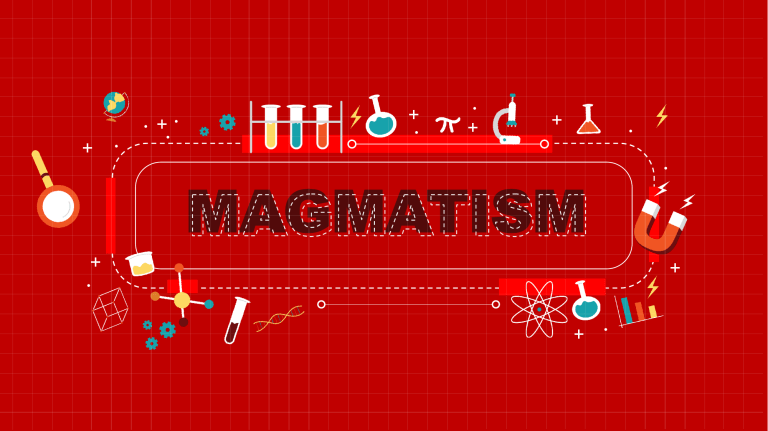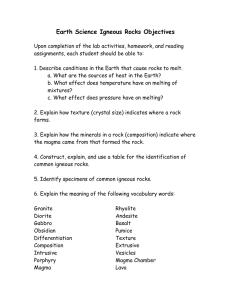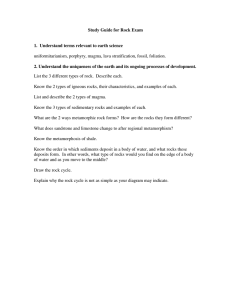
MAGMATISM GROUP 1 THE MICROWAVE Andrei Agana Daryl Libosada Earl Lawrence Iban James Kenneth Balquin Janelle May Balagan OBJECTIVES Describe how magma is formed Describe the chemical composition of magma Differentiate the three types of magma Describe the characteristic of magma WHAT IS VOLCANO? - is an opening in the Earth's surface and a mountain formed where rocks, smoke, gases, and ashes are erupted. - A volcano is a landform (usually a mountain) where molten rock erupts through the surface of the planet. - In simple terms a volcano is a mountain that opens downward to a pool of molten rock (magma) below the surface of the earth. It is a hole in the Earth from which molten rock and gas erupt. WHAT CAUSES VOLCANOES TO ERUPT? - The Earth's crust is made up of huge slabs called plates, which fit together like a jigsaw puzzle. These plates sometimes move. - Between the Earth's crust and the mantle is a substance called magma which is made of rock and gases. When two plates collide, one section slides on top of the other, the one beneath is pushed down. Magma is squeezed up between two plates. PARTS OF THE VOLCANO Volcanic Ash cloud Vent Magma - Molten rock beneath Earth's surface. - A flat piece of rock formed when magma hardens in a crack in a volcano. - An opening in Earth's surface through which volcanic Conduit (pipe) materials escape. - Molten rock that erupts from a volcano that solidifies as it cools. - Mouth of a volcano - surrounds a volcanic vent. - An underground passage magma travels through. - Highest point; apex t - Entrance of a volcano. The part of the conduit that ejects lava and volcanic ash. - A cloud of ash formed by volcanic explosions A large pool of liquid rock beneath the surface of the earth is the mid-portion and elevated part of the volcano is the portion at ground level Crater Throat Sill Magma chamber 01 WHAT IS - Magma forms from partial melting of mantle rocks. -Magma is extremely hot liquid and semi-liquid rock located under Earth’s surface. -Magma is a mixture of minerals. It also contains small amounts of dissolved gases such as water vapor, carbon dioxide, and sulfur. The high temperatures and pressure under Earth’s crust keep magma in its fluid state 02 WHERE DOES FORMS? - On average, melting happens at depths below about 50 kilometers but above a few hundred kilometers - Although rocks can melt every where, there are three environments in which melting is common due to mechanisms that help to increase the temperature of the rocks 03 PHIVOLCS TYPES OF - Involves the upward movement of the earth’s mostly-solid mantle - Decompression melting often occurs at divergent boundaries, where tectonic plates seperate column of hot rock that rise from the Earth’s surface high pressure core to its lowerpressure crust. push magma onto the seafloor and can grow into volcanic islands over million of years of activity - Happens at convergent boundaries, where tectonic plates are crashing together melting the surrounding rocks into magma. - As the denser tectonic plate subducts, hot rock below can intrude into the cooler plate abpve - Occurs when water or other volatile components are added to rock - These compounds cause the rock to melt at lower temperatures. 04 PHIVOLCS THREE TYPES OF - Forms at the mid-ocean ridges or at hot spots under the ocean crust, and is high in iron and magnesium, but is low in silica - These minerals have a relatively high density - Low viscosity - Also known as granitic magma, forms from the partial melting of continental crust and is low in iron and magnesium , but high in silica - These minerals have a relatively low density - High viscosity - Forms when the magma did not erupt, but instead slowly crystallized within Earth’s curst. - This magma has a medium silica content - Is made in subduction zones 04 PHIVOLCS RISE OF IS CONTROLLED BY: MAGMA VISCOSITY CONTROL/FACTORS ON VISCOSITY measure of resistance to flow. higher Si02 content = higher viscosity magma is resistant to flow (flows very slowly/creates explosive eruptions) magma flows freely (flows very quickly), creates quiet, non-explosive reactions. higher temperature = lower viscosity higher water = lower viscosity METAMORPHISM WHAT IS METAMORPHISM? - Metamorphic rocks are like sedimentary rocks in the sense that they are both “recycled” rocks (derived from pre-existing rocks). - The process a pre-existing rock transform into another form of rock - “Meta” means changed and “Morphe” means form 01 FACTORS AFFECT METAMORPHISM 1. Pressure - Measure of the stress or physical force applied to the surface of a material - The higher the pressure, the greater the degree of metamorphism - Pressure steadily increases with depth Pressure is applied in 3 different ways: PORE PRESSURE- the pressure applied by fluids trapped in sediments or grains of porous rocks Pressure is applied in 3 different ways: LOAD PRESSURE- the weight of overlying rocks that physically brings minerals into contact with each other over verry long periods of time TECTONIC PRESSURE- rocks undergo folding or faulting due to very high pressure exerted over relatively shot period of time 2. Temperature - As a temperature increase, the rate of me - Temperature also increases with depth, due to the geothermal gradient 3. Fluid SHALE SLATE PHYLLITE SCHIST - Metamorphism can significantly alter a rock’s mineralogy by introducing or removing chemical components what dissolve in water GNEISS 02 METAMORPHIC GRADE 1. L ow -grade metamorphis m Examples: - Take place at temperature between 200 to 320 degrees C, and relatively low pressure 2 . Mid -grade metamorphis m Examples: - Take place at approximately at 320-450 C and at moderate pressure 3 . High -grade metamorphis m Examples: - Take place at temperature above 450 C 03 METAMORPHIC ROCK TEXTURES 1. Foliated GRANITE - Have a layered or banded appearance that is produced by exposure to heat and direct pressure. - Foliated rocks are most often formed from mudstones and contain “fine-grained” or “platy” minerals that are usually too small to see with the naked eye BIOTITE 2. Non-Foliated MARBLE - These have no evident planar fabric or foliation, crystallized under conditions where there were no differential stress, and are comprised of minerals - Created if the pressure applied to the recrystallizing rock is equal all over QUARZSITE 04 TYPES OF METAMORPHISM 1. Regional metamorphism - Caused by large geologic processes such as mountainbuilding. This is commonly associated with convergent plate boundaries and the formation of mountain ranges 2. Contact metamorphism - Occurs when magma comes in contact with an already existing body of rock - When this happens the existing rocks temperatures rises and also becomes penetrated with fluid from the magma THANK YOU FOR LISTENING!







